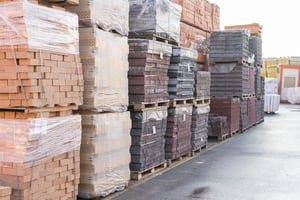Brick is likely the most popular building material in use today. Throughout the world, builders use various forms and styles of brick to erect every kind of building imaginable. Brick making is an ancient craft, passed along from ancient cultures and refined over time.
Early Brick Making
 Brick has been used as a building material since 7000 BC. The earliest bricks were discovered around ancient Jericho in southern Turkey. Bricks from this time were made from various types of mud and dried in the sun. Ancient Egyptians mixed straw with the mud to add strength to their bricks. Around 3500 BC, builders invented ways to fire mud bricks without the heat of the sun. Brick making was now possible in cooler climates.
Brick has been used as a building material since 7000 BC. The earliest bricks were discovered around ancient Jericho in southern Turkey. Bricks from this time were made from various types of mud and dried in the sun. Ancient Egyptians mixed straw with the mud to add strength to their bricks. Around 3500 BC, builders invented ways to fire mud bricks without the heat of the sun. Brick making was now possible in cooler climates.
The ancient Roman brick makers invented mobile kilns, by which they could travel anywhere making and selling fired bricks for construction projects. The local Roman legion supervising the area operations typically emblazoned bricks fired in their territory with their mark. Roman bricks were made in all kinds of shapes and as large as three feet in length. Romans spread brick making throughout Europe until their empire fell, when it nearly vanished.
German and Italian brick making during the twelfth century contributed to Gothic architecture that spread throughout Baltic nations from Sweden to Estonia and even Russia. By the sixteenth century, brick was an important factor in Renaissance architecture.
By the reign of Henry VIII in England, brick making had become a highly advanced science. After the great fire of London in 1666, the city was rebuilt mainly with bricks.
American Brick Making
British and Dutch brick masons brought brick making across the Atlantic to the new colonies. It is believed that the first permanent American brick kiln was erected at Salem, Massachusetts in 1621, although bricks were being made in Virginia as early as 1612. History records that bricks were shipped from Virginia to Bermuda to be traded for oil and food in 1621.
Bricks were still formed into molds by hand until around 1885 and the beginning of the Industrial Revolution. When machinery was introduced to form and produce brick, science also introduced a greater number of clays that could be used to make brick. By 1925, a single brick making machine could turn out 12,000 bricks per day. Compare that to handmade brick production that may produce up to 36,000 bricks per week.
Many early American skyscrapers are clad in brick. For example, the Empire State Building used 10 million bricks in its outer façade. During the building boom of the nineteenth century, over 10 billion bricks were produced every year. Because bricks were heavy and therefore expensive to transport, many American cities like Washington, DC, Boston and New York preferred their own locally made bricks. At the turn of the 20th century there were nearly 100 brickyards in Washington, DC.
Brick Making Today
 After a time through the World War II era when brick making saw a significant decline, bricks are in popular use today. Brick homes and commercial buildings can be seen on practically every street in America. Many historic homes from different periods feature brick outer facades in addition to decorative brickwork.
After a time through the World War II era when brick making saw a significant decline, bricks are in popular use today. Brick homes and commercial buildings can be seen on practically every street in America. Many historic homes from different periods feature brick outer facades in addition to decorative brickwork.
Brick making today has been shaped by science, as brick makers explore factors such as brick durability, color, texture (including coatings and glazes), size variation, compressive strength and absorption. But many older brick structures are still in use. These buildings feature a softer brick that allows for moisture evaporation. They also typically feature a softer, lime-based mortar between bricks.
Older buildings with these softer building materials must be repaired with a technique called tuckpointing, where a softer, lime-based mortar is used to replace crumbling joints. Also, when necessary, softer brick is used to replace cracked or broken bricks in walls and facades.
When you have an older building that needs brick work, call the experts at Renaissance Development. We are your Washington DC area specialists in tuckpointing and historic brick preservation.
2/28/20 3:23 PM

